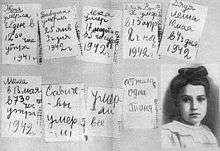Tanya Savicheva
| Tatyana Nikolayevna Savicheva | |
|---|---|
|
6-year-old Tanya Savicheva, 1936 | |
| Born |
January 23, 1930 Village of Dvorishchi, Gdov, Leningrad Oblast (now Pskov Oblast), Russian SFSR, Soviet Union |
| Died |
July 1, 1944 (aged 14) Settlement of Shatki, Gorky Oblast, Russian SFSR, Soviet Union |
| Cause of death | Intestine tuberculosis |
| Resting place | Cemetery of Shatki |
| Nationality | Russian |
| Parent(s) |
Nikolay Rodionovich Savichev (1884–1936) Mariya Ignatievna Savicheva (née Fyodorova) (1889–1942) |
| Relatives |
Siblings: Yevgenia (1909–1941), Leonid (1917–1942), Nina (born on November 23, 1918), Mikhail (1921–1988) Yevdokia Grigorievna Fyodorova (née Arsenieva) (1867–1942) (grandmother) |

Tatyana Nikolayevna Savicheva (Russian: Татья́на Никола́евна Са́вичева), commonly referred to as Tanya Savicheva (January 23, 1930 – July 1, 1944) was a Russian child diarist who endured the Siege of Leningrad during World War II.
Early life
Born on January 23, 1930, she was the youngest child in the family of baker Nikolay Rodionovich Savichev and seamstress Mariya Ignatievna Savicheva. Her father died when Tanya was six, leaving Mariya Savicheva with five children: three girls—Tanya, Zhenya (Yevgenia) and Nina—and two boys—Mikhail and Leka (Leonid).
The family planned to spend the summer of 1941 in the countryside, but the Axis invasion of the Soviet Union on June 22 disrupted their plans. All of them, except Mikhail (Misha), who had already left, decided to stay in Leningrad. Each of them worked to support the army: Mariya Ignatievna sewed uniforms, Leka worked as a plane operator at the Admiralty Plant, Zhenya worked at the munitions factory, Nina worked at the construction of city defences, and Uncle Vasya and Uncle Lesha served in the anti-aircraft defence. Tanya, then 11 years old, dug trenches and put out firebombs.
One day Nina went to work and never came back; she was sent to Lake Ladoga and then urgently evacuated. The family was unaware of this and thought she had died.
Origins of the diary
After a few days in memory of Nina, Mariya Ignatievna gave to Tanya a small notebook that belonged to her sister and that would later become Tanya's diary. Tanya had a real diary once, a thick notebook in which she recorded everything important in her life. She burned it when nothing was left to heat the stove in winter, but she spared her sister's notebook.
Tanya first wrote in the diary on December 28; her account was about her older sister, Zhenya. Each day Zhenya got up before the sun and walked seven kilometers to the plant, where she worked for two shifts every day making mine cases. After the work, she would donate blood. Her weakened body could not endure the repeated donations, and she died at the plant where she worked. Shortly thereafter, most of Tanya's family also died in succession - her grandmother Yevdokiya Grigorievna, her brother Leka, two of her uncles, and finally her mother.
In August 1942, Tanya was one of the 140 children who were rescued from Leningrad and brought to the village of Krasny Bor. Anastasiya Karpova, a teacher in the Krasny Bor orphanage, wrote to Tanya's brother Mikhail, who happened to be outside of Leningrad in 1941: "Tanya is now alive, but she doesn't look healthy. A doctor, who visited her recently, says she is very ill. She needs rest, special care, nutrition, better climate and, most of all, tender motherly care." In May 1944, Tanya was sent to a hospital in Shatki, where she died a month later, on July 1, of intestinal tuberculosis.[1]
According to several sources, one of the documents presented by the Allied prosecutors during the Nuremberg Trials was the small notebook that once belonged to Tanya,[2][3][4] but there appears to be no proof of this[5] and an argument against its veracity being that if the diary had been really presented at the Nuremberg Trials it would have never left the court archives.
Nina Savicheva and Mikhail Savichev returned to Leningrad after World War II. The diary of Tanya Savicheva is now displayed at the Museum of Leningrad History and a copy is displayed at the Piskaryovskoye Memorial Cemetery.
Contents of the diary
Zhenya died on Dec. 28th at 12:00 P.M. 1941
Grandma died on Jan. 25th 3:00 P.M. 1942
Leka died on March 17th at 5:00 A.M. 1942
Uncle Vasya died on Apr. 13th at 2:00 after midnight 1942
Uncle Lesha on May 10th at 4:00 P.M. 1942
Mother on May 13th at 7:30 A.M. 1942
Savichevs died.
Everyone died.
Only Tanya is left.[6]
Legacy
Tanya and her diary have become an iconic image of the victims of the siege of Leningrad in the postwar Soviet Union. In May 1972, a memorial was constructed in her honor in Shatki, which was later expanded to a memorial complex.[1]
Serbian poet Miroslav Antic wrote a poem "A lost rendez-vous" dedicated to Tanya.[7]
2127 Tanya, a minor planet discovered in 1971 by Soviet astronomer Lyudmila Chernykh, is named in her honor.[1][8]
See also
References
| Wikimedia Commons has media related to Tanya Savicheva. |
- 1 2 3 Миксон, Илья Львович (1991). Жила-была (in Russian). Leningrad: Detskaya Literatura. p. 219. ISBN 5-08-000008-2. Retrieved 10 March 2009.
- ↑ Natalia Mikhaylenko (January 30, 2013). "Leningrad siege: The captive's diary". Russia Beyond The Headlines. Retrieved March 26, 2015.
- ↑ "Prominent Russians: Tanya Savicheva". Russiapedia. Retrieved March 26, 2015.
- ↑ Anastasia (translator) (July 2, 2007). "The Diary of Tanya Savicheva". Orthodoxy and the World. Retrieved March 26, 2015.
- ↑ Paul K. Lyons (July 1, 2014). "Only Tanya is Left". The Diary Review. Retrieved March 26, 2015.
- ↑ Tanya Savicheva diary from blockade Leningrad
- ↑ http://miroslavantic.blogspot.com/2008/08/jedan-izgubljeni-randevu.html
- ↑ Schmadel, Lutz D. (2003). Dictionary of Minor Planet Names (5th ed.). New York: Springer Verlag. p. 172. ISBN 3-540-00238-3.
